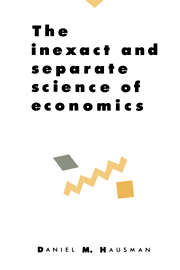Part I - Introduction, structure, and strategy
Published online by Cambridge University Press: 04 August 2010
Summary
Part I provides an introductory account of microeconomics, general equilibrium theory, and welfare economics; links simple models (like those found in textbooks and easy applications) to fundamental theory, and explores the structure and strategy of economic theorizing. Although the first four chapters provide an introduction to microeconomics and welfare theory, their presentation is unlike a standard textbook. For I shall begin (chapter 1) with the theory of rationality that is implicit in economics and shall show how it ties together the theory of consumer choice (chapter 2), the theory of production and general equilibrium (chapter 3), and the normative theory of economic welfare (chapter 4). Building on the results of the first four chapters, chapters 5 and 6 will offer a general account of the structure and strategy of (neoclassical) economic theorizing, which I hope to make vivid with the case study in chapter 7. Only then, in part II, shall I turn to the problem of assessment.
The first four chapters raise a number of questions concerning economic theory that I try to answer later. I shall make a few specific criticisms of, for example, revealed preference theory and the identification of individual welfare with the satisfaction of preferences, but in general I have tried to keep introduction and criticism separate. The many questions I shall raise concerning apparently odd features of economics are genuine, not rhetorical, and are not intended as veiled criticism.
- Type
- Chapter
- Information
- The Inexact and Separate Science of Economics , pp. 11 - 12Publisher: Cambridge University PressPrint publication year: 1992



